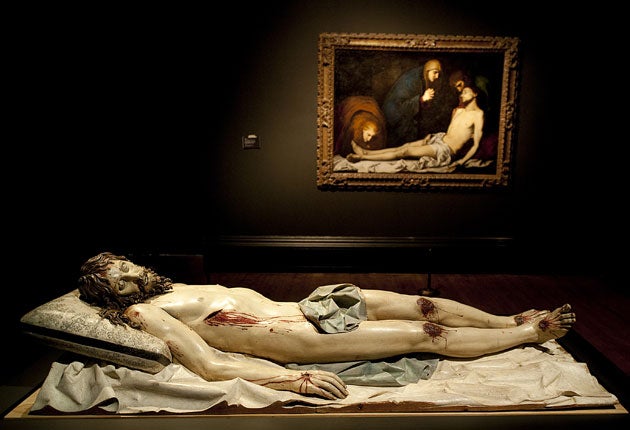The Sacred Made Real: Spanish Painting and Sculpture 1600-1700, National Gallery, London
Sacred images pull more punches in two dimensions than in three, as an exhibition both absorbing and repellent powerfully shows

Your support helps us to tell the story
From reproductive rights to climate change to Big Tech, The Independent is on the ground when the story is developing. Whether it's investigating the financials of Elon Musk's pro-Trump PAC or producing our latest documentary, 'The A Word', which shines a light on the American women fighting for reproductive rights, we know how important it is to parse out the facts from the messaging.
At such a critical moment in US history, we need reporters on the ground. Your donation allows us to keep sending journalists to speak to both sides of the story.
The Independent is trusted by Americans across the entire political spectrum. And unlike many other quality news outlets, we choose not to lock Americans out of our reporting and analysis with paywalls. We believe quality journalism should be available to everyone, paid for by those who can afford it.
Your support makes all the difference.At the heart of the National Gallery's new show, The Sacred Made Real, lies a question intended to vex: why do we find 17th-century Spanish religious painting so easy to look at, 17th-century Spanish religious sculpture so hard? Why does Zurbaran's canvas of St Francis Standing in Ecstasy strike us as sublime, Pedro de Mena's wooden effigy of the same subject as cheesy?
To answer that, we need to bear various things in mind. First, the work in this show is Spanish, not Italian. When the excavation of ancient Rome began in the 15th century, dug-up findings were scrubbed clean. The resultant monochrome objects were, in their whiteness, red herrings. Much classical sculpture had actually been painted, its colours lost in the ground. Nonetheless, the Italian Renaissance went away believing that Classical painting had been coloured and Classical sculpture white, and that the twain had never met. Michelangelo, a classicist and a colourist, is thought to have made just one painted sculpture in his long career, and that when he was 17.
Spain, though, had little of this history, and thus less of a bias towards sculptural whiteness. As a result, one of the curious things about the painted wooden figures in The Sacred Made Real is how old-fashioned they seem to our Italian-trained eyes. Gregorio Fernandez's Ecce Homo may have all the twist and turn of the Baroque, but it still, in 1621, looks Gothic.
There is another problem, which is that we see the sculptures in The Sacred Made Real from a distance of 400 years, and from an Anglican, if not godless, country. The Counter-Reformation, begun at the Council of Trent in 1545, fought Protestant intellectualism by becoming ever more bodily. The Council reaffirmed tangible things – the transubstantiation of wine into blood, saints' relics, pilgrimages, the sacraments. At the same time, the Church turned mystical. Among the greatest of the new mystics was a trio of Spaniards, Saints Ignatius Loyola, Teresa of Avila and John of the Cross.
It is the last of these whose presence is most clearly felt in the National Gallery show. "Darkness is preparation for light," wrote the poet-saint, a one-time apprentice wood carver. More than anywhere else, this emphatically Spanish embrace of the dark, of the equation between physical pain and spiritual gain, found its voice in three dimensions – in these sacred effigies made to be knelt down before in churches, carried in procession through ringing streets. Protestantism, bleak but inexplicably successful, stressed the intellectual link between man and God. Counter-Reformation Spain demanded a fleshly riposte, and she got it from the likes of Mena and Juan Martinez Montañes.
What is the difference between Zurbaran's St Francis and Mena's? In terms of fitness for purpose, the second is arguably the greater work. Questions might be all very well for Protestants, but Catholics wanted answers and Mena gives them, in three dimensions and with little glass eyes. Zurbaran, by contrast, requires a leap of the imagination, most immediately to grasp that the patently two-dimensional thing we see before us is a three-dimensional figure. Unlike Mena's, Zurbaran's saint won't meet our eye, his gaze being lifted to heaven. For him, as for we who stand before him, looking is matter of faith.
Something else you'll notice about the painted St Francis is Zurbaran's clear attempt to show his subject's robes as monolithic and carved, which is to say as sculptural. The overlap between painting and painted sculpture in 17th-century Spain was certainly there: Diego Velazquez, the greatest artist of the age, was taught wood-painting by his father-in-law, Francisco Pacheco. But the sculpturalism of Zurbaran's canvases can be taken in two ways – as an attempt to harness the gravitas of painted wood or, contrariwise, to deny it: to advertise, quietly but inarguably, the superiority of two-dimensional paint over three.
Stand in front of Juan Martinez Montañes's life-size effigies of Saints Ignatius Loyola and Francis Borgia and you may well end up feeling that Zurbaran had a point. Borgia, Superior of the Jesuits, was beatified the year his image was made, in 1624; his face was probably coloured in by Velazquez's father-in-law. The work is undoubtedly finely made, even if not finely painted. (Pacheco, in another life, churned out turgid religious canvases.) The trouble is that it is so true to life – crystal tears trickle down the saint's sallow cheek – that it is clearly not alive: for all its grandeur, it is just a muñeco, a doll. And yet Montañes's work has probably inspired more belief in its time than Zurbaran's, and belief, after all, was the point.
To 24 Jan (020-7747 2885)
Join our commenting forum
Join thought-provoking conversations, follow other Independent readers and see their replies
Comments